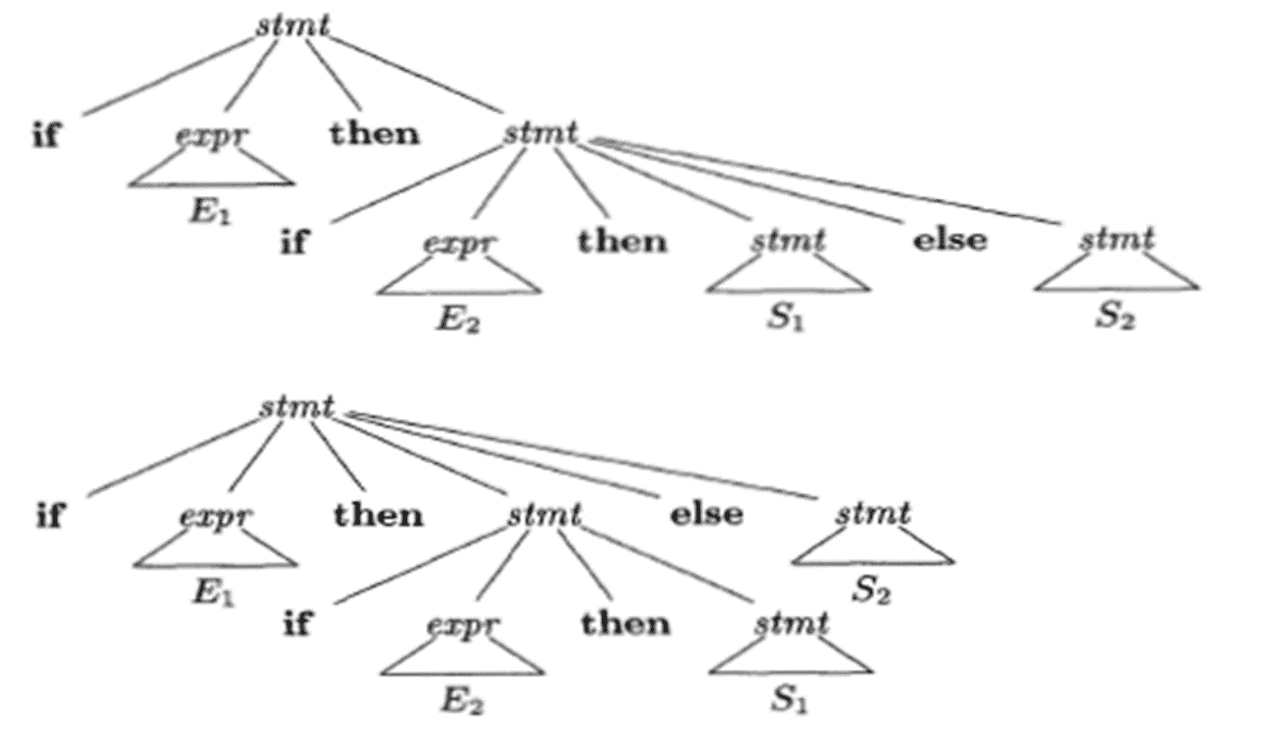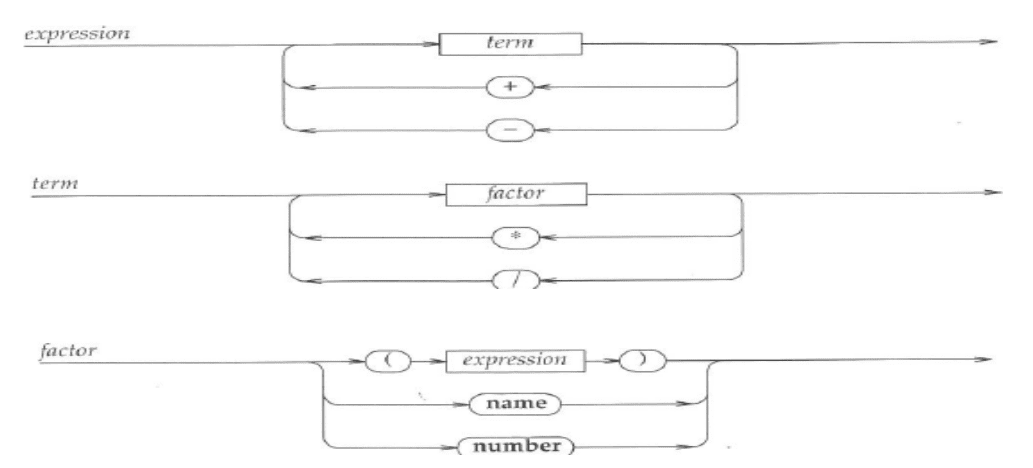03 Language Description
Syntax vs Semantics¶
| Syntax | Semantics |
|---|---|
| Structure of expressions, statements, program units | Meaning of expressions, statements, program units |
| - Lexical layer - Grammar layer |
Grammar¶
Means of
- describing a language: all possible legally-correct programs
- analyzing a sentence: check if program is valid
- derive a sentence: program
Notations¶
| Example | Easy to decode during left-right scan | Parenthesis-free | Operands of each operator can be found unambiguously | Can be evaluated with | |
|---|---|---|---|---|---|
| Prefix | \(+ ab\) | ✅ | ✅ | ✅ | - Tree - Stack |
| Postfix | \(ab +\) | ❌ | ✅ | ✅ | - Tree - Queue |
| Infix | \(a+b\) | ❌ | ❌ | ❌ | - Tree |
| Mixfix | If \(a>b\) then \(a\) else \(b\) - if, then, else are keywords- \(a, b\) are components of expression | ❌ | ❌ | ❌ |
Infix Notation¶
Associativity¶
- Left: \(+, -, *, /\)
- Right: \(=,\) ^
Precedence¶
BODMAS
- Brackets
- Orders (Powers, Indices, Roots)
- Division
- Multiplication
- Addition
- Subtraction
Abstact Syntax Tree¶
identifies meaningful components of each construct in the language
\(+ab, \ a+b, \ ab+\)¶
all have the same abstract syntax tree
flowchart TB
+ --> a & bif \(a > b\), then \(a\), else \(b\)¶
flowchart TB
stmt --> if & e1 & then & stmt1 & else & stmt2
e1 --> x["a>b"]
stmt1 --> a
stmt2 --> bLexical Syntax¶
group characters of source program into meaningful sequence (omitting blank spaces and comments) and generate tokens/terminals
Syntax of token¶
Token Classes¶
| Class | Example |
|---|---|
| Keyword | if, else, while |
| Operator | \(+ - * /\) |
| Identifier (Variables) | max, a, total |
| Constant (Numeric/String constant) | pi |
| Punctuation Marks | \(, ; () [] \{ \}\) |
| Number | \(1 \ 2 \ 3 \ \dots\) |
Example¶
\(a*b-4\) has the following tokens
CFG¶
Context-Free Grammar
Used to specify grammar of non-regular expressions (refer Theory of Computation)
Parts¶
- Set of tokens/terminals
- Set of non-terminals
- Set of rules/productions Each production has a
- non-terminal on its left hand-side
- \(::=\) or \(\rightarrow\) on right-hand side
- String of terminals/non-terminals on right-hand side
- A Non terminal is chosen as the starting non-terminal Unique starting terminal is called starting symbol
BNF¶
Bacus Naur Form
used to specify grammar
Parts¶
- Terminal appear as keyword, opeator, identifiers, constant, punctuation mark
- Non-terminals are enclosed between \(< >\) Eg: < fraction >
- Productions
- Read \(::=\) as ‘can be’
- Read \(|\) or
Example¶
- < fraction > \(::=\) < digit > | < digit >< fraction > Fraction can be digit or a digit followed by fraction
CFG for real number BNF¶
- < real-number > \(::=\)
. < fraction > - < integer_part > \(::=\) < digit > |
< digit > - < fraction > \(::=\) < digit > | < digit >< fraction >
- < digit > \(::=\) 0 | 1 | 2 | 3 | 4 | 5 | 6 | 7 | 9
Parse Tree¶
Also called as Concrete Syntax Tree
Tree built using starting non-terminal and productions
Construction of a parse tree is called parsing
Generates the string formed by reading terminals at its leaves from left to right
A string is only in a language if it is generated by some parse tree
Rules¶
- Root is labeled with the starting non terminal
- Each non-leaf is labeled with a non terminal
- Each leaf is labeled with a terminal
Example¶
\(123.789\)
flowchart TB
rn[Real Number]
rn --> i1[Integer-Part] & . & f1[Fraction]
i1 --> d1[Digit] & i2[Integer-Part]
i2 --> d2[Digit] & i3[Integer-Part]
i3 --> d3[Digit]
f1 --> d7[Digit] & f2[Fraction]
f2 --> d8[Digit] & f3[Fraction]
f3 --> d9[Digit]
d1 --> 1
d2 --> 2
d3 --> 3
d7 --> 7
d8 --> 8
d9 --> 9Ambiguous Grammar¶
A grammar for a language is syntactically ambiguous, if some string in its language has more than one parse tree.
Dangling Else¶
if E1 then if E2 then S1 else S2 has 2 parse trees with the following grammar
- S \(::=\) if E then S
- S \(::=\) if E then S else S

Math¶
\(2+3*5\) has 2 parse trees with the following grammar
- < expr > \(::=\) < expr > < op > < expr> | < digit >
- < op > \(::=\) + | - | * | /
- < digit > \(::= 0 | 1 | 2 | …. | 9\)
Derivations¶
Text version of Parse Tree
| Top-Down Derivation | Bottom-Up Derivation |
|---|---|
| Start from Starting symbol and derive the sentence. | Start from the sentence and reach the start symbol. |
| Replace the LHS of a production by RHS | Replace the RHS of a production by the LHS |
| Leftmost Derivation | Rightmost Derivation |
|---|---|
| Leftmost nonterminal is replaced repeatedly | Rightmost nonterminal is replaced repeatedly |
Example¶
Real Number
real-number \(\implies\) integer-part . fraction \(\implies\) integer-part digit.fraction
Grammar for Expressions¶
- Left-Recursive Grammars handle
- Right-Recursive Grammars handle right-associativity
| Left-Recursive | Right-Recursive | |
|---|---|---|
| Handles | Left-associativity | Right-associativity |
| Example | \(L ::= L + \text{num} \ L – \text{num} \vert \text{num}\) | \(R ::= \text{num} + R \vert \text{num} – R \vert \text{num}\) |
Operator Precedence¶
(Low to High)
| Operator | Meaning |
|---|---|
| \(=\) | Assignment |
| \(\vert \vert\) | Logical or |
| \(\&\&\) | Logical and |
| \(\vert\) | inclusive or |
| ^ | exclusive or |
| \(\&\) | and |
| \(== \ \ \ne\) | equality |
| \(< \ \le \ \ge \ >\) | relational |
| \(<< \ \ >>\) | shift |
| \(+ -\) | additive |
| \(* / \%\) | multiplicative |
| \(\uparrow\) | exponentiation |
Operator Association¶
| Association | |
|---|---|
| Left | \(+ - */\) |
| Right | \(= \ \uparrow\) |
Extended BNF¶
- Braces \(\{ \}\) represent zero/more repetitions
- Brackets \([]\) represent optional contruct
- Vertical bar \(|\) represents a choice
- Parentheses \(()\) are used for grouping
- \(E =\) Expression
- \(T =\) Term
- \(F =\) Factor
Syntax Chart¶

The above can be represented as ⬇
